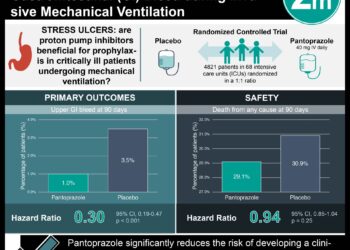Quality improvement initiative increases rates of evidence-based ventilation strategy in NICU
1. In this single center quality improvement study, the use of any volume-targeted ventilation in premature infants increased by 16%, and exclusively volume-targeted ventilation increased by 280%.
2. Increased volume-targeted ventilation did not alter infant outcomes, including mortality, bronchopulmonary dysplasia, severe intraventricular hemorrhage, or duration of mechanical ventilation.
Evidence Rating Level: 2 (Good)
Study Rundown: Premature infants often require mechanical ventilation to assist with breathing. Although this treatment is lifesaving, it also increases the risk of complications such as bronchopulmonary dysplasia. Volume-targeted ventilation (VTV), which sets a target lung volume and reduces the pressure delivered as lung compliance increases, has been associated with better outcomes than pressure-limited ventilation (PLV), which delivers a set pressure with every breath. This study implemented quality improvement (QI) initiatives within a multidisciplinary team to increase the usage of VTV, with the goal of decreasing rates of bronchopulmonary dysplasia in the NICU. QI initiatives included standardization of procedures, improved team communication, system optimization, and education. The usage of any VTV and exclusive VTV significantly increased over the 3 year study period. The greatest improvements were seen after standardization of mechanical ventilation initiation and changes were made to the ventilator interface screen. Despite increased rates of VTV, clinical outcomes were unchanged. However, clinical outcomes of VTV compared to PLV in this study should be interpreted with caution, as over 80% of infants were already receiving VTV prior to the intervention. Overall, this study provides a framework for other NICUs looking to increase evidence-based ventilation strategies.
Click to read the study in PEDIATRICS
Relevant Reading: Neonatal mechanical ventilation: Indications and outcomes
In-Depth [prospective cohort]: This quality improvement study included a 98-bed, level 4 academic NICU at Vanderbilt University Medical Center. In total, 1225 infants with a total of 213, 751 ventilator hours were included in the study over a 3-year period. Three time periods were assessed: baseline, epoch 1 (improving volume-targeted ventilation and decreasing pressure-limited ventilation), and epoch 2 (improving use of exclusively volume-targeted ventilation). At the end of the study period, use of any volume-targeted ventilation increased from 83% at baseline to 94% and 96% after epoch 1 and 2, respectively (p<0.001). Use of exclusively volume-targeted ventilation increased from 27% during baseline to 61% and 76% after epoch 1 and epoch 2, respectively (p<0.001). There were no significant differences in any infant clinical outcomes, including mortality, bronchopulmonary dysplasia, severe intraventricular hemorrhage, and duration of mechanical ventilation required.
Image: PD
©2021 2 Minute Medicine, Inc. All rights reserved. No works may be reproduced without expressed written consent from 2 Minute Medicine, Inc. Inquire about licensing here. No article should be construed as medical advice and is not intended as such by the authors or by 2 Minute Medicine, Inc.







